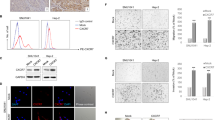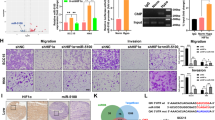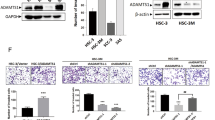Abstract
We previously reported a vascular endothelial growth factor (VEGF) autocrine loop in head and neck squamous cell carcinoma (HNSCC) cell lines, supporting a role for VEGF in HNSCC tumorigenesis. Using a phosphotyrosine proteomics approach, we screened the HNSCC cell line, squamous cell carcinoma-9 for effectors of VEGFR2 signaling. A cluster of proteins involved in cell migration and invasion, including the p130Cas paralog, human enhancer of filamentation 1 (HEF1/Cas-L/Nedd9) was identified. HEF1 silencing and overexpression studies revealed a role for VEGF in regulating cell migration, invasion and matrix metalloproteinase (MMP) expression in a HEF1-dependent manner. Moreover, cells plated on extracellular matrix-coated coverslips showed enhanced invadopodia formation in response to VEGF that was HEF1-dependent. Immunolocalization revealed that HEF1 colocalized to invadopodia with MT1-MMP. Analysis of HNSCC tissue microarrays for HEF1 immunoreactivity revealed a 6.5-fold increase in the odds of having a metastasis with a high HEF1 score compared with a low HEF1 score. These findings suggest that HEF1 may be prognostic for advanced stage HNSCC. They also show for the first time that HEF1 is required for VEGF-mediated HNSCC cell migration and invasion, consistent with HEF1's recent identification as a metastatic regulator. These results support a strategy targeting VEGF:VEGFR2 in HNSCC therapeutics.
This is a preview of subscription content, access via your institution
Access options
Subscribe to this journal
Receive 50 print issues and online access
$259.00 per year
only $5.18 per issue
Buy this article
- Purchase on Springer Link
- Instant access to full article PDF
Prices may be subject to local taxes which are calculated during checkout






Similar content being viewed by others
References
Alexander NR, Branch KM, Parekh A, Clark ES, Iwueke IC, Guelcher SA et al. (2008). Extracellular matrix rigidity promotes invadopodia activity. Curr Biol 18: 1295–1299.
Arold ST, Hoellerer MK, Noble MEM . (2002). The structural basis of localization and signaling by the focal adhesion targeting domain. Structure 10: 319–327.
Ayala I, Baldassarre M, Giacchetti G, Caldieri G, Tete S, Luini A et al. (2008). Multiple regulatory inputs converge on cortactin to control invadopodia biogenesis and extracellular matrix degradation. J Cell Sci 121: 369–378.
Bachelder RE, Lipscomb EA, Lin X, Wendt MA, Chadborn NH, Eickholt BJ et al. (2003). Competing autocrine pathways involving alternative neuropilin-1 ligands regulate chemotaxis of carcinoma cells. Cancer Res 63: 5230–5233.
Badowski C, Pawlak G, Grichine A, Chabadel A, Oddou C, Jurdic P et al. (2008). Paxillin phosphorylation controls invadopodia/podosomes spatiotemporal organization. Mol Biol Cell 19: 633–645.
Bigbee WL, Grandis JR, Siegfried JM . (2007). Multiple cytokine and growth factor serum biomarkers predict therapeutic response and survival in advanced-stage head and neck cancer patients. Clin Cancer Res 13: 3107–3108.
Bowden ET, Onikoyi E, Slack R, Myoui A, Yoneda T, Yamada KM et al. (2006). Co-localization of cortactin and phosphotyrosine identifies active invadopodia in human breast cancer cells. Exp Cell Res 312: 1240–1253.
Brabek J, Constancio SS, Siesser PF, Shin N-Y, Pozzi A, Hanks SK . (2005). Crk-associated substrate tyrosine phosphorylation sites are critical for invasion and metastasis of Src-transformed cells. Mol Cancer Res 3: 307–315.
Brown MC, Turner CE . (2004). Paxillin: adapting to change. Physiol Rev 84: 1315–1339.
Buday L, Downward J . (2007). Roles of cortactin in tumor pathogenesis. Biochim Biophys Acta 1775: 263–273.
Canel M, Secades P, Rodrigo JP, Cabanillas R, Herrero A, Suarez C et al. (2006). Overexpression of focal adhesion kinase in head and neck squamous cell carcinoma is independent of fak gene copy number. Clin Cancer Res 12: 3272–3279.
Carpenter AE, Jones TR, Lamprecht MR, Clarke C, Kang IH, Friman O et al. (2006). CellProfiler: image analysis software for identifying and quantifying cell phenotypes. Genome Biol 7: R100.
Clark ES, Whigham AS, Yarbrough WG, Weaver AM . (2007). Cortactin is an essential regulator of matrix metalloproteinase secretion and extracellular matrix degradation in invadopodia. Cancer Res 67: 4227–4235.
Cohen LA, Guan JL . (2005). Mechanisms of focal adhesion kinase regulation. Curr Cancer Drug Targets 5: 629–643.
Cooney MM, Tserng KY, Makar V, McPeak RJ, Ingalls ST, Dowlati A et al. (2005). A phase IB clinical and pharmacokinetic study of the angiogenesis inhibitor SU5416 and paclitaxel in recurrent or metastatic carcinoma of the head and neck. Cancer Chemother Pharmacol 55: 295–300.
Descamps FJ, Martens E, Opdenakker G . (2002). Analysis of gelatinases in complex biological fluids and tissue extracts. Lab Invest 82: 1607–1608.
Fashena SJ, Einarson MB, O'Neill GM, Patriotis C, Golemis EA . (2002). Dissection of HEF1-dependent functions in motility and transcriptional regulation. J Cell Sci 115: 99–111.
Ferrara N . (2004). Vascular endothelial growth factor: basic science and clinical progress. Endocr Rev 25: 581–611.
Gimona M, Buccione R, Courtneidge SA, Linder S . (2008). Assembly and biological role of podosomes and invadopodia. Curr Opin Cell Biol 20: 235–241.
Guarino M, Rubino B, Ballabio G . (2007). The role of epithelial-mesenchymal transition in cancer pathology. Pathology 39: 305–318.
Izumchenko E, Singh MK, Plotnikova OV, Tikhmyanova N, Little JL, Serebriiskii IG et al. (2009). NEDD9 promotes oncogenic signaling in mammary tumor development. Cancer Res 69: 7198–7206.
Jemal A, Tiwari RC, Murray T, Ghafoor A, Samuels A, Ward E et al. (2004). Cancer statistics, 2004. CA Cancer J Clin 54: 8–29.
Ji H, Ramsey MR, Hayes DN, Fan C, McNamara K, Kozlowski P et al. (2007). LKB1 modulates lung cancer differentiation and metastasis. Nature 448: 807–810.
Kim M, Gans JD, Nogueira C, Wang A, Paik JH, Feng B et al. (2006). Comparative oncogenomics identifies NEDD9 as a melanoma metastasis gene. Cell 125: 1269–1281.
Kratchmarova I, Kalume DE, Blagoev B, Scherer PE, Podtelejnikov AV, Molina H et al. (2002). A proteomic approach for identification of secreted proteins during the differentiation of 3T3-L1 preadipocytes to adipocytes. Mol Cell Proteomics 1: 213–222.
Kyzas PA, Stefanou D, Batistatou A, Agnantis NJ . (2005). Potential autocrine function of vascular endothelial growth factor in head and neck cancer via vascular endothelial growth factor receptor-2. Mod Pathol 18: 485–494.
Linder S . (2007). The matrix corroded: podosomes and invadopodia in extracellular matrix degradation. Trends Cell Biol 17: 107–117.
Lua BL, Low BC . (2005). Cortactin phosphorylation as a switch for actin cytoskeletal network and cell dynamics control. FEBS Lett 579: 577–585.
Michi Y, Morita I, Amagasa T, Murota S . (2000). Human oral squamous cell carcinoma cell lines promote angiogenesis via expression of vascular endothelial growth factor and upregulation of KDR/flk-1 expression in endothelial cells. Oral Oncol 36: 81–88.
Minn AJ, Gupta GP, Siegel PM, Bos PD, Shu W, Giri DD et al. (2005). Genes that mediate breast cancer metastasis to lung. Nature 436: 518–524.
Molinolo AA, Hewitt SM, Amornphimoltham P, Keelawat S, Rangdaeng S, Meneses Garcia A et al. (2007). Dissecting the Akt/mammalian target of rapamycin signaling network: emerging results from the head and neck cancer tissue array initiative. Clin Cancer Res 13: 4964–4973.
Mon NN, Ito S, Senga T, Hamaguchi M . (2006). FAK signaling in neoplastic disorders: a linkage between inflammation and cancer. Ann NY Acad Sci 1086: 199–212.
Nakamoto T, Yamagata T, Sakai R, Ogawa S, Honda H, Ueno H et al. (2000). CIZ, a zinc finger protein that interacts with p130(cas) and activates the expression of matrix metalloproteinases. Mol Cell Biol 20: 1649–1658.
Natarajan M, Stewart JE, Golemis EA, Pugacheva EN, Alexandropoulos K, Cox BD et al. (2006). HEF1 is a necessary and specific downstream effector of FAK that promotes the migration of glioblastoma cells. Oncogene 25: 1721–1732.
O'Neill GM, Seo S, Serebriiskii IG, Lessin SR, Golemis EA . (2007). A new central scaffold for metastasis: parsing HEF1/Cas-L/NEDD9. Cancer Res 67: 8975–8979.
Ormandy CJ, Musgrove EA, Hui R, Daly RJ, Sutherland RL . (2003). Cyclin D1, EMS1 and 11q13 amplification in breast cancer. Breast Cancer Res Treat 78: 323–335.
Patel AM, Incognito LS, Schechter GL, Wasilenko WJ, Somers KD . (1996). Amplification and expression of EMS-1 (cortactin) in head and neck squamous cell carcinoma cell lines. Oncogene 12: 31–35.
Rheinwald JG, Beckett MA . (1981). Tumorigenic keratinocyte lines requiring anchorage and fibroblast support cultures from human squamous cell carcinomas. Cancer Res 41: 1657–1663.
Ries L, Eisner M, Kosary C, Hankey B, Miller B, Clegg L et al. (2004). SEER Cancer Statistics Review, 1975–2001, National Caner Institute. Bethesda, MD, http://seer.cancer.gov/csr/1975_2001/.
Rothschild BL, Shim AH, Ammer AG, Kelley LC, Irby KB, Head JA et al. (2006). Cortactin overexpression regulates actin-related protein 2/3 complex activity, motility, and invasion in carcinomas with chromosome 11q13 amplification. Cancer Res 66: 8017–8025.
Ruest PJ, Shin N-Y, Polte TR, Zhang X, Hanks SK . (2001). Mechanisms of CAS substrate domain tyrosine phosphorylation by FAK and Src. Mol Cell Biol 21: 7641–7652.
Rush J, Moritz A, Lee KA, Guo A, Goss VL, Spek EJ et al (2005). Immunoaffinity profiling of tyrosine phosphorylation in cancer cells. Nat Biotechnol 23: 94–101.
Sabe H, Onodera Y, Mazaki Y, Hashimoto S . (2006). ArfGAP family proteins in cell adhesion, migration and tumor invasion. Curr Opin Cell Biol 18: 558–564.
Sanz-Moreno V, Gadea G, Ahn J, Paterson H, Marra P, Pinner S et al (2008). Rac activation and inactivation control plasticity of tumor cell movement. Cell 135: 510–523.
Simpson KJ, Selfors LM, Bui J, Reynolds A, Leake D, Khvorova A et al (2008). Identification of genes that regulate epithelial cell migration using an siRNA screening approach. Nat Cell Biol 10: 1027–1038.
Singh MK, Cowell L, Seo S, O'Neill GM, Golemis EA . (2007). Molecular basis for HEF1/NEDD9/Cas-L action as a multifunctional co-ordinator of invasion, apoptosis and cell cycle. Cell Biochem Biophys 48: 54–72.
Singh MK, Dadke D, Nicolas E, Serebriiskii IG, Apostolou S, Canutescu A et al (2008). A novel Cas family member, HEPL, regulates FAK and cell spreading. Mol Biol Cell 19: 1627–1636.
Slack-Davis JK, Martin KH, Tilghman RW, Iwanicki M, Ung EJ, Autry C et al (2007). Cellular characterization of a novel focal adhesion kinase inhibitor. J Biol Chem 282: 14845–14852.
Sloan EK, Anderson RL . (2002). Genes involved in breast cancer metastasis to bone. Cell Mol Life Sci 59: 1491–1502.
Slomiany MG, Black LA, Kibbey MM, Day TA, Rosenzweig SA . (2006). IGF-1 induced vascular endothelial growth factor secretion in head and neck squamous cell carcinoma. Biochem Biophys Res Commun 342: 851–858.
Slomiany MG, Black LA, Kibbey MM, Tingler MA, Day TA, Rosenzweig SA . (2007). Insulin-like growth factor-1 receptor and ligand targeting in head and neck squamous cell carcinoma. Cancer Lett 248: 269–279.
Steen H, Kuster B, Fernandez M, Pandey A, Mann M . (2002). Tyrosine phosphorylation mapping of the epidermal growth factor receptor signaling pathway. J Biol Chem 277: 1031–1039.
Tachibana K, Urano T, Fujita H, Ohashi Y, Kamiguchi K, Iwata S et al (1997). Tyrosine phosphorylation of Crk-associated substrates by focal adhesion kinase. A putative mechanism for the integrin-mediated tyrosine phosphorylation of Crk-associated substrates. J Biol Chem 272: 29083–29090.
Tehrani S, Tomasevic N, Weed S, Sakowicz R, Cooper JA . (2007). Src phosphorylation of cortactin enhances actin assembly. Proc Natl Acad Sci USA 104: 11933–11938.
Timpson P, Lynch DK, Schramek D, Walker F, Daly RJ . (2005). Cortactin overexpression inhibits ligand-induced down-regulation of the epidermal growth factor receptor. Cancer Res 65: 3273–3280.
van Nimwegen MJ, van de Water B . (2007). Focal adhesion kinase: a potential target in cancer therapy. Biochem Pharmacol 73: 597–609.
Weaver AM . (2008). Cortactin in tumor invasiveness. Cancer Lett 265: 15912–15920.
Yu Y-H, Kuo H-K, Chang K-W . (2008). The evolving transcriptome of head and neck squamous cell carcinoma: a systematic review. PLoS ONE 3: e3215.
Acknowledgements
We thank Amanda M Brock for excellent technical assistance, Jennifer Bethard and Dr Kevin Schey (MUSC Mass Spectrometry Facility), the HCC Cell and Molecular Imaging Shared Resource, the HCC Tissue Biorepository and Dr Elizabeth Garrett-Mayer, Director (HCC Biostatistics Shared Resource) for aid and consultations. We are indebted to Drs Terry Day and M Boyd Gillespie for human specimens and Drs Silvio Gutkind and Alfredo Molinolo (NIDCR) for tissue microarrays. This work was supported by a MUSC Summer Health Research Fellowship, a Paul Calabresi Fellowship (PhRMA Foundation), an Abney Foundation Award, the Southeastern Pre-Doctoral Training in Clinical Research T32 (JTL), NIH grants CA78887 and CA134845 (SAR), DOD award (N6311601MD10004) to HCC and the American Health Assistance Foundation (SAR). Portions of this work were presented at the Annual Meeting of the AACR, 2008, San Diego, CA, USA and the Annual Meeting of the Endocrine Society, 2008, San Francisco, CA, USA.
Author information
Authors and Affiliations
Corresponding author
Ethics declarations
Competing interests
The authors declare no conflict of interest.
Additional information
Supplementary Information accompanies the paper on the Oncogene website
Supplementary information
Rights and permissions
About this article
Cite this article
Lucas, J., Salimath, B., Slomiany, M. et al. Regulation of invasive behavior by vascular endothelial growth factor is HEF1-dependent. Oncogene 29, 4449–4459 (2010). https://doi.org/10.1038/onc.2010.185
Received:
Revised:
Accepted:
Published:
Issue Date:
DOI: https://doi.org/10.1038/onc.2010.185
Keywords
This article is cited by
-
Tumor microenvironment differences between primary tumor and brain metastases
Journal of Translational Medicine (2020)
-
Effect of tumor microenvironment on pathogenesis of the head and neck squamous cell carcinoma: a systematic review
Molecular Cancer (2019)
-
A pyrrole-based natural small molecule mitigates HSP90 expression in MDA-MB-231 cells and inhibits tumor angiogenesis in mice by inactivating HSF-1
Cell Stress and Chaperones (2017)
-
NEDD9/Arf6-dependent endocytic trafficking of matrix metalloproteinase 14: a novel mechanism for blocking mesenchymal cell invasion and metastasis of breast cancer
Oncogene (2015)
-
Prognostic significance of the tumour-adjacent tissue in head and neck cancers
Tumor Biology (2015)



